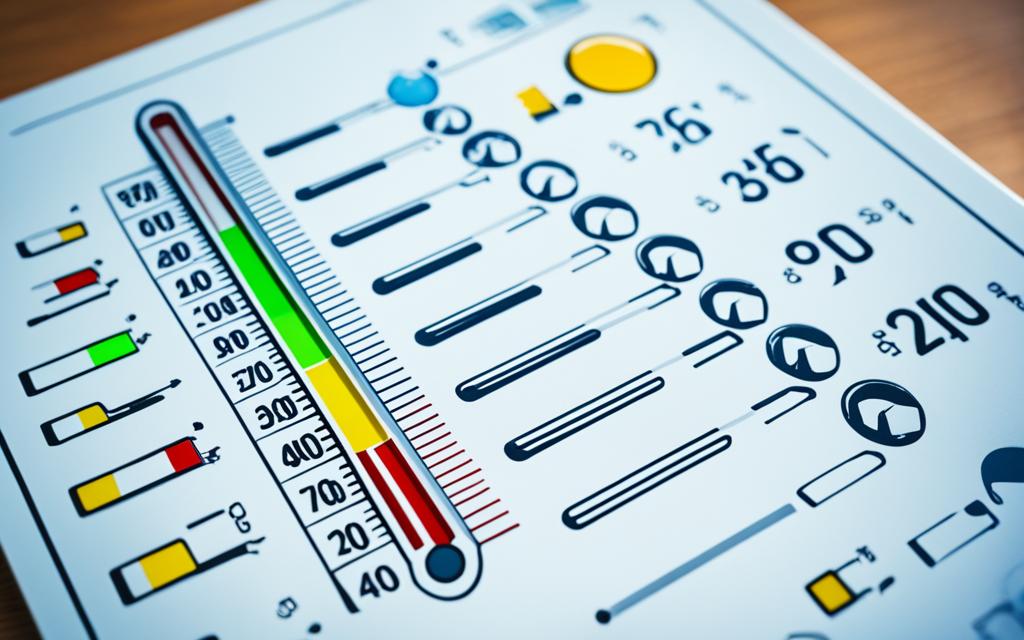Table of Contents
Knowing the safe CPU temperatures is key for great performance and preventing damage. The Central Processing Unit (CPU) is your computer’s core, handling commands and multitasking. It gets hot because of this hard work. Learning the best CPU temperature ranges helps avoid serious issues and hardware damage.
We will look at recommended temperature ranges, why temperatures vary, and how to keep your system cool. Keeping your CPU in the safe range boosts its efficiency and durability. For tips on checking your CPU’s temperature, see this guide1.
Key Takeaways
- Safe CPU temperatures typically range from 30-40 degrees Celsius when idle.
- During intensive tasks, it’s crucial to maintain CPU temperatures between 70-80 degrees Celsius.
- Exceeding temperatures of 80 degrees Celsius can lead to thermal throttling, affecting performance.
- Good airflow systems are essential for managing CPU temperatures in desktops.
- Utilising third-party software can help monitor CPU temperatures accurately.
Understanding CPU Temperatures
The function of a computer largely depends on its CPU, the system’s brain. Knowing what is a CPU helps us understand its impact on performance. It’s critical to keep an eye on CPU heat generation because the CPU takes care of tasks and carries out commands, warming up as it works. This heat comes from the electrical resistance in the CPU’s circuits. It changes with the CPU’s design, the amount of work it does, and how well it’s cooled.
What is a CPU and Its Function?
A CPU, or Central Processing Unit, is key to a computer for reading and following through with instructions. A capable CPU speeds up and refines how a computer works. These units manage a lot of jobs, from easy sums to complex simulations. Grasping CPU function helps us value its importance in today’s tech world.
How CPUs Generate Heat
Running programs and solving problems make CPU heat generation a normal thing due to electrical activities. The busier the CPU, the hotter it gets. Regular CPU temperatures vary from 40–65°C (104–149°F) in normal use, but heavy tasks or gaming can push that to 70–80°C (158–176°F)2. Although these heat levels are manageable for most modern CPUs, continually hitting 80-85°C (176–185°F) suggests a problem3. It’s essential to use cooling techniques to keep temperatures safe.
Normal Operating Temperatures for CPUs
Knowing the right temperatures for CPUs helps them last longer and work better. It’s key to watch the temperature when the CPU isn’t doing much and when it’s working hard.
Idle Temperatures
Idle CPU temperature is usually between 30°C to 40°C. This happens when the CPU isn’t busy. But when in use, CPUs are safe from 40°C to 80°C. Going over this might mean there’s a problem with cooling, like old thermal paste or not enough air getting through4.
Under Load Temperatures
The temperature jumps up during tough tasks, like gaming or complex calculations. Typically, the load CPU temperature reaches from 60°C to 90°C4. High-end CPUs, like the 13th Gen. Core i9, might even get close to 100°C when pushed. But long times over 90°C can slow them down and even cause harm5. Cooling systems, including fans and thermal paste, are crucial for keeping things cool5.
Checking CPU temperatures regularly is good for your computer. This way, you avoid overheating and help your CPU last longer5.
What Are Safe CPU Temperatures
Knowing the right CPU temperature is key to keeping your computer running well. CPUs work best within a certain temperature zone. This depends on the type and how hard it’s working.
Stay Within the Recommended Ranges
It’s best to keep CPU temperature under 80°C when it’s working hard. For most of the time, 40-70 degrees Celsius is the sweet spot6. When your computer is not doing much, it should be cooler, around 30-40 degrees Celsius. With routine tasks, you’ll see 40-60 degrees Celsius. For gamers, 60-85 degrees Celsius is okay.
But, if temperatures go above 85°C, your computer might slow down to avoid damage. This is called throttling6.
Factors Influencing Safe Temperatures
Many things can affect your CPU’s temperature. The type of CPU, the room’s temperature, and how good your cooling system is matter. Intel gives a safe temperature for its CPUs. For example, it recommends 71.4°C for the Q9400 and 64°C for the i5-6600K7. Experts agree that keeping temperatures below 85°C is best for your computer’s health7.
Other things like overclocking and how air moves inside your computer can also influence temperature.
Signs Your CPU is Overheating
It’s crucial to spot the early signs of CPU overheating to keep your system healthy. When your CPU gets too hot, it starts to show performance issues. Keep an eye out for these indicators to prevent overheating problems.
Performance Issues
When the heat goes up, you’ll notice your computer isn’t working as well. Things might slow down, freeze, or the computer could shut down by itself. If the inside of a CPU gets hotter than 70 degrees Celsius, it starts to not work right8. If you don’t manage the heat, your computer won’t be as efficient, affecting how well you can work9.
Thermal Throttling Explained
Thermal throttling is like a safety net for your CPU when it gets too hot. If the temperature gets too high, the CPU slows down to avoid damage10. This saves your CPU from getting harmed. It’s very important to keep an eye on how hot your CPU is to stop it from getting too hot9.
To avoid overheating, watch out for signs like bad airflow or dust. If you see these signs, check your cooling system to make sure it’s working right10.
How to Check Your CPU Temperature
It’s important to monitor your CPU temperature to keep it running smoothly and avoid overheating. There are a few good ways to do this, like looking at BIOS readings or using special software.
Using BIOS for Temperature Monitoring
Checking your CPU temperature via BIOS is a direct method. When you start your computer, you can go into the BIOS to see your CPU’s current temperature. This approach is great because it shows the temperature without any software interference.
Third-Party Software Options
Third-party software is handy for regular temperature checks during use. Tools like Core Temp and HWMonitor let you see your CPU temperature and more. They give details on CPU use and past performance. These programs are especially useful for Windows 10/11 users. They help ensure your CPU works within a safe temperature range of 45-100°C. Overheating beyond these limits can cause damage or affect performance.
Using these software tools regularly helps you manage your computer’s heat. Actions like cleaning dust from your PC and improving airflow can increase its life and efficiency1112.
Common Causes of High CPU Temperatures
Knowing why your CPU gets hot is key to keeping your computer running well. One big problem is poor airflow in your PC case. This can really limit how well your parts stay cool. When airflow is blocked by messy cables or not enough air gets in, your CPU can get 5-15 degrees Celsius hotter. It’s very important to make sure air can move easily in your case. Also, fans should be set up the right way to move air through.
Poor Airflow in Your PC Case
Dust building up on important parts like fans and heat sinks can also make it hotter, by about 5-10 degrees Celsius. You should clean your PC often, like every few months, to stop dust from blocking the heat from getting out. Also, the thermal paste between your CPU and its cooler is crucial. If it’s not put on right or needs changing, it can make your CPU up to 10-20 degrees Celsius warmer1314.
Dust Accumulation and Maintenance Tips
To avoid overheating, keep your PC well-ventilated and clean it regularly. This will help keep it cool and reduce the chance of overheating. So, watch your system’s temperatures. You can use software tools to monitor CPU performance and temperature. Knowing these can help you spot problems early, before they get worse.
FAQ
What are the safe temperature ranges for a CPU?
A CPU should run between 30°C to 40°C when not doing much. With some use, it gets warmer, reaching 60°C to 70°C. Under a lot of work, temperatures might go up to 70°C to 80°C. Keep it under 80°C to avoid overheating.
What should I do if my CPU is overheating?
If your CPU gets too hot, better airflow inside your PC is crucial. Clean the dust off components often. Ensure the cooling system works well. It’s important to check the cooling paste between the CPU and its cooler for efficient heat removal.
How can I monitor my CPU’s temperature?
You can check your CPU’s temperature when you start your computer, through the BIOS.
Programs like Core Temp also show how hot your CPU is while you use your computer. This is great for keeping an eye on temperature changes.
What factors can influence CPU temperature?
Several things affect CPU temperature. These include its design, how much work it does, the room’s temperature, and how good your cooling system is. Keeping air moving is vital for your CPU to work well.
What happens if my CPU exceeds safe temperature limits?
If a CPU gets too hot, it slows down by lowering its speed. This action reduces heat but can make your computer slower, freeze, or even turn off unexpectedly.
What are common causes of high CPU temperatures?
High CPU temperatures often come from not enough air getting around inside the PC, dust clogging up vital parts, or thermal paste not applied correctly. Cleaning your computer regularly helps avoid these problems.
What temperature is considered ideal for CPU operation?
The best temperature for a CPU depends on its tasks but stays between 30°C and 70°C. For top performance and safety, keep it below 80°C.
How does thermal throttling work?
Thermal throttling cuts down a CPU’s speed to prevent it from getting too hot. This feature keeps your CPU safe but might slow it down temporarily.
Source Links
- https://rockymtnruby.com/what-cpu-temperature-is-considered-safe/ – What CPU Temperature is Considered Safe? – Rocky MTN Ruby
- https://www.avast.com/c-how-to-check-cpu-temperature – How to Check and Monitor Your CPU Temperature
- https://www.noyafa.com/blogs/knowledge-base/good-cpu-temperature – What Is A Good CPU Temperature? A Guide to Keep Your Processor Cool
- https://www.linkedin.com/advice/3/what-normal-optimal-ranges-cpu-temperature-different – What are the normal and optimal ranges of CPU temperature for different types of processors?
- https://community.spiceworks.com/t/what-is-a-normal-temperature-for-a-cpu-and-how-do-i-keep-it-low/948818 – What is a normal temperature for a CPU and how do I keep it low?
- https://computercity.com/hardware/processors/normal-cpu-temperatures – Normal CPU Temperatures: Guidelines for Safe & Optimal Performance – ComputerCity
- https://forums.tomshardware.com/threads/is-my-cpu-temperature-safe.3725283/ – [SOLVED] – Is my cpu temperature safe?
- https://www.avast.com/c-fix-computer-overheating – Why Is Your Computer Overheating and How to Cool It Down
- https://www.linkedin.com/advice/0/what-common-causes-symptoms-cpu-overheating-skills-computer-repair – What are the common causes and symptoms of CPU overheating?
- https://techvilleonline.com/is-your-computer-overheating-6-signs-it-is-and-how-to-fix-it/ – Is Your Computer Overheating?: 6 Signs It is And How to Fix It
- https://softwarekeep.com/blogs/how-to/how-to-check-cpu-temp-in-windows-10-11 – How To Check Your CPU Temperature in Windows 10/11
- https://www.pcmag.com/how-to/how-to-monitor-your-cpu-temperature – cpu temperature monitor
- https://www.lenovo.com/us/en/glossary/what-is-cpu-temperature/ – Cpu Temperature: What is CPU Temperature?
- https://softwareg.com.au/blogs/computer-hardware/my-cpu-temp-is-90 – My CPU Temp Is 90








